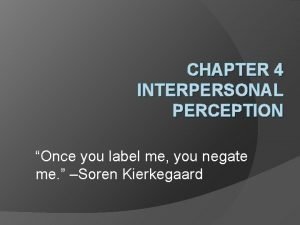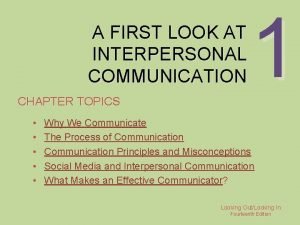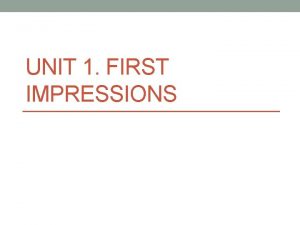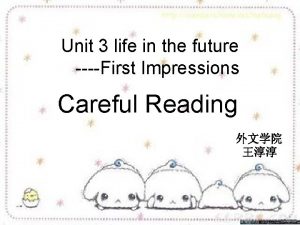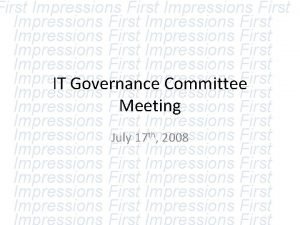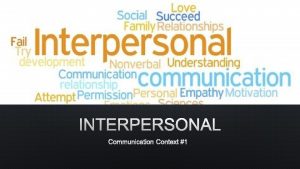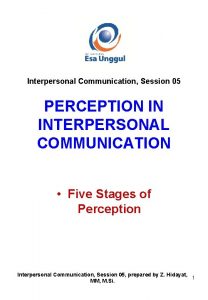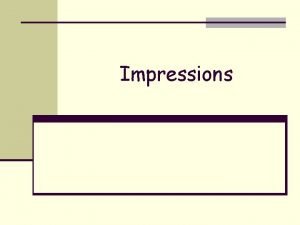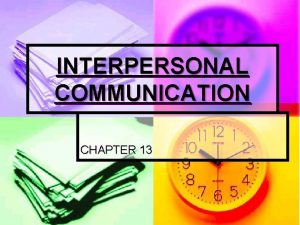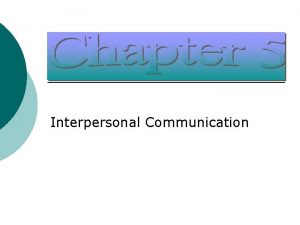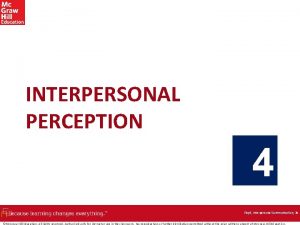Exploring Interpersonal Communication First Impressions Perception how we















- Slides: 15

Exploring Interpersonal Communication

First Impressions Perception • how we process and interpret cues from a person’s outward appearance, voice, and language usage. Schemata • mental patterns that “help us identify and organize incoming information. ” Three basic patterns • person prototypes • personal constructs • scripts

Expectations and Boundaries Informational peers • +/- equal level of status • Low level of trust and disclosure • Little to no expectation for feedback or support Collegial peers • +/- equal level of status • Moderate level of trust and disclosure • Moderate expectation for feedback or support Special peers • +/- equal level of status • High level of trust and disclosure • High expectation for feedback or support

Organizational Boundaries Rules • Assumptions and formal pronouncements about proper communication among employees Policies • Explicitly developed guidelines regarding conduct in the workplace Cultures • Evolved standards for communication practices • May be unique to the organization • Must be acquired through observation and experience


Behaving Ethically Trust each other Treat each other with respect Recognize the value of each individual Keep your word • do what you say you will do Tell the truth Act with integrity Be open to change Risk failing in order to improve Learn and try new ideas

Strategic Messages Creating messages that reflect self, other and context involves these concepts: • • • Equity Self disclosure and risk taking Feedback Dialectics Dialogue Conflict resolution

Equity The principle that we should be treated fairly by others and treat others fairly Four key assumptions • People work for rewards • People seek equity • People become stressed when they feel they are being treated unfairly • People experiencing stress will try to restore equity

Self-Disclosure and Risk Taking People expect equity in self-disclosure and risk-taking. Disclosure and risk have commodity value in the workplace. Principles of self-disclosure and risk-taking: • If I offer disclosures about myself, I expect you to offer disclosures about yourself. • If I take risks in our relationship, I am encouraging you to take risks in our relationship.

Feedback Providing others with an evaluation of the effectiveness of their actions. Five rules for giving feedback: own your message avoid apologizing for your feelings make your message specific and behavioral ensure that your verbal and nonverbal behaviors support each other • avoid evaluating and interpreting your communication partner unless he/she asks you to do so • •

Dialectics Refers to the interaction of two arguments that are by nature oppositional. Three primary sources of relational dialectics: • autonomy-togetherness • novelty-predictability • expressive-protective

Dialogue Communication that focuses on mutuality and relational growth rather than on selfinterest. Ways to create dialogue in organizations • focus on mutuality • discover rather than disclose • be more interested in access than domination

Conflict The feelings or perceptions of imbalance that arise in a relational setting. Behaviors to avoid in a conflict situation: • • withdrawing accommodating compromising avoiding or postponing

Cultural Differences Individualist cultures • revere the individual person • value democratic relationships and are • less influenced by status or hierarchy when dealing with others. Collectivist cultures, • revere the common good over self-interest, • value group and family identity over individual achievement, • tend to respect vertical status hierarchies.

Gender Differences Orient yourself to the differences in men and women’s communication style. • Report-building • Rapport-building Avoid stereotyping. Be flexible.
 Tire tread impressions are always plastic impressions
Tire tread impressions are always plastic impressions Exploring interpersonal communication
Exploring interpersonal communication Perception checks
Perception checks Fundamental forces in interpersonal perception
Fundamental forces in interpersonal perception Impersonal communication
Impersonal communication Examples of mass communication
Examples of mass communication Impression vocabulary
Impression vocabulary Once done never forgotten
Once done never forgotten First impression paragraph
First impression paragraph Grendel setting
Grendel setting What are your first impressions of beowulf?
What are your first impressions of beowulf? First impressions count reading answers
First impressions count reading answers A wear pattern cut gouge
A wear pattern cut gouge First impressions finger print
First impressions finger print The landlady setting
The landlady setting First impressions
First impressions



